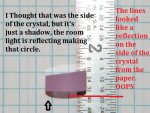D
Deleted member 49011
Guest
Re: Short large diameter ND: YAG Crystal with Brewster Angle?
YVO4 isn't a SHG crystal , KTP is used to perform the 1064nm to 532nm SHG in most cases or LBO sometimes .
Nd:Yag & Nd:Yvo4 both lase at 1064nm hence why they are both seen in 532nm systems
I have no idea, usually an 808nm pumped ND-YAG is frequency doubled with a YV04 to make 532nm, I have not seen Brewster's angle used except in gas lasers such as argon. I have not worked with any ruby lasers. EDIT I meant helium neon, lol.
I assume it was to strip off polarized light using the angle as the output, but that's just a wild guess.
EDIT : I take that back, I think it's pumped through that angle.
YVO4 isn't a SHG crystal , KTP is used to perform the 1064nm to 532nm SHG in most cases or LBO sometimes .
Nd:Yag & Nd:Yvo4 both lase at 1064nm hence why they are both seen in 532nm systems
Last edited by a moderator:









